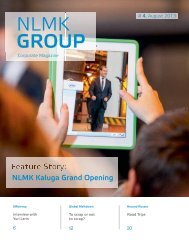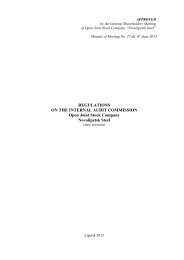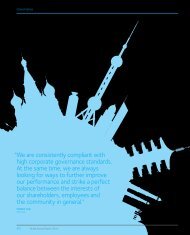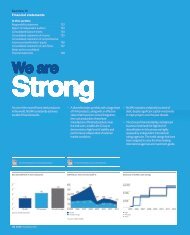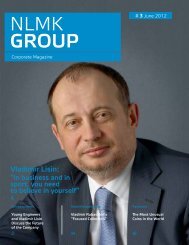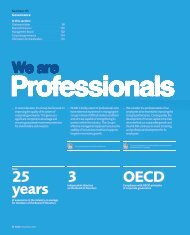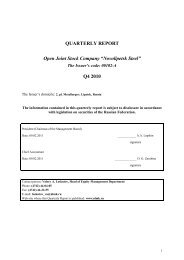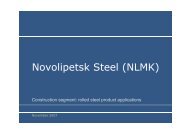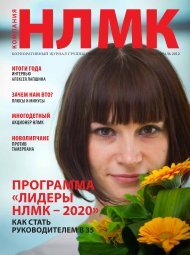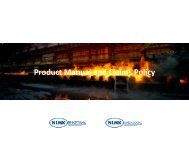NLMK Group
NLMK Group
NLMK Group
Create successful ePaper yourself
Turn your PDF publications into a flip-book with our unique Google optimized e-Paper software.
5<br />
Economy and Production GLOBAL STEEL INDUSTRY<br />
Crisis Knocking<br />
on the Door. Again<br />
The state of the global economy remains challenging and uncertain. Experts are forecasting a slowdown<br />
in economic growth in 2012, with the biggest challenges faced by the European Union and the United States.<br />
Today we see a trend<br />
of consistently strong prices<br />
for raw materials coupled<br />
with slowing demand<br />
for steel<br />
The International Monetary<br />
Fund has cautioned that<br />
Europe and the US may go into<br />
another recession unless they<br />
address the pressing economic<br />
challenges. “The global economy<br />
is in a dangerous new phase.<br />
Global activity has weakened and<br />
become more uneven, confidence<br />
has fallen sharply recently, and<br />
downside risks are growing,”<br />
suggests the IMF’s World<br />
Economic Outlook published in<br />
September.<br />
Growing global concerns<br />
about a potential new round<br />
of the financial crisis have<br />
prompted ‘pre-crisis’ attitude in<br />
the real sector,<br />
as everyone still<br />
has a very clear<br />
recollection of the<br />
impact caused<br />
by the downturn<br />
in late 2008 and<br />
2009. The steel industry has<br />
always served as a mirror of core<br />
macroeconomic developments,<br />
and now these recent disquieting<br />
sentiments have begun to affect<br />
the steel sector. Consumers of<br />
steel products prefer to keep<br />
their inventories at the lowest<br />
possible levels, having learned<br />
well the lesson from the previous<br />
crisis. Analysts suggest that<br />
given the current unfavorable<br />
economic environment the steel<br />
market would recover to some<br />
equilibrium level only if output<br />
was reduced. These tendencies<br />
can already be seen in the sector:<br />
capacity utilization is declining,<br />
and this is especially true in those<br />
parts of the world where demand<br />
continues to be fairly weak,<br />
while the cost of producing steel<br />
is no longer competitive given<br />
the current prices for finished<br />
products. This applies to Europe,<br />
first of all, which shows the<br />
world’s lowest self-sufficiency in<br />
iron ore and coal, the two main<br />
inputs.<br />
At first sight even in China<br />
the developments do not look<br />
promising. The country’s<br />
government has been successfully<br />
attempting to offset lower<br />
exports by encouraging domestic<br />
consumption, and is focusing<br />
on the stronger development<br />
of inward oriented sectors,<br />
and implementing large-scale<br />
construction and infrastructure<br />
development projects. At the<br />
same time the authorities are<br />
trying to prevent the economy<br />
from overheating by pursuing<br />
a balanced financial policy. As<br />
long as the situation in Europe<br />
remained more or less stable<br />
China has been able to find a<br />
balance, but a worsening of the<br />
problems in the US and the Euro<br />
area may have an impact, albeit<br />
limited, on China as well, as the<br />
country is currently consuming<br />
almost half of all steel produced<br />
globally.<br />
Competition within the global<br />
ferrous metals industry will<br />
increase, and so will increase<br />
the integration of manufacturers,<br />
especially in the raw materials<br />
sector. This will be encouraged by<br />
an ever more restricted access to<br />
raw materials, including iron ore,<br />
coal and ferrous scrap. Today we<br />
see a trend of consistently strong<br />
prices for raw materials coupled<br />
with slowing demand for steel.<br />
This is yet another reminder of the<br />
need to elaborate a sustainable<br />
business model which would<br />
always allow for a flexible<br />
response to the challenges posed<br />
by the market.<br />
Recently, the steel sector has<br />
seen an increase in the share of<br />
raw materials in the overall costs<br />
of production. For some nonintegrated<br />
manufacturers these<br />
reach almost 90% of the price<br />
of hot-rolled products. <strong>NLMK</strong><br />
did take this trend into account.<br />
The development of upstream<br />
capacities and further scaling<br />
down of costs are seen as the core<br />
pre-requisites for maintaining<br />
competitiveness. At the same<br />
time, stronger output of finished<br />
products allows the Company to<br />
significantly expand its ability to<br />
respond to changes in a flexible<br />
manner.<br />
<strong>NLMK</strong>’s business model is based<br />
on the reliance on the advantages<br />
of making steel in Russia and it<br />
is justified from the perspective<br />
of the sector’s logistics. Russian<br />
assets remain the main driver<br />
of growth for the Company.<br />
And the availability of rolling<br />
capacity located close to endconsumers<br />
provides the Company<br />
with the opportunity to expand<br />
its presence in large European<br />
and US markets at the lowest



